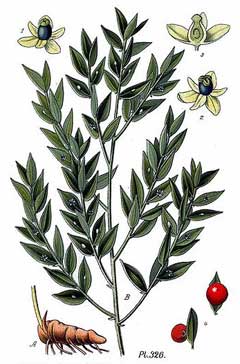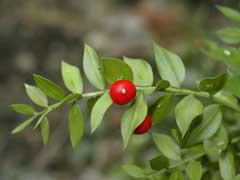 |
|
http://commons.wikimedia.org/wiki/File:326_Ruscus_aculeatus_L.jpg |
 |
|
Translate this page:
Summary
Physical Characteristics

 Ruscus aculeatus is an evergreen Shrub growing to 0.8 m (2ft 7in) by 1 m (3ft 3in) at a slow rate.
Ruscus aculeatus is an evergreen Shrub growing to 0.8 m (2ft 7in) by 1 m (3ft 3in) at a slow rate.
See above for USDA hardiness. It is hardy to UK zone 7. It is in leaf all year, in flower from January to April, and the seeds ripen from August to March. The species is dioecious (individual flowers are either male or female, but only one sex is to be found on any one plant so both male and female plants must be grown if seed is required). and is pollinated by Insects. The plant is not self-fertile.
Suitable for: light (sandy), medium (loamy) and heavy (clay) soils, prefers well-drained soil and can grow in heavy clay and nutritionally poor soils. Suitable pH: mildly acid, neutral and basic (mildly alkaline) soils and can grow in very alkaline soils.
It can grow in full shade (deep woodland) or semi-shade (light woodland). It prefers dry or moist soil and can tolerate drought.
UK Hardiness Map
US Hardiness Map
Synonyms
Ruscus flexuosus. Ruscus laxus. Ruscus parasiticus. Ruscus ponticus
Habitats
Woodland Garden Dappled Shade; Shady Edge; not Deep Shade; Ground Cover;
Edible Uses
Edible Parts: Shoots Stem
Edible Uses: Coffee
Young shoots - cooked[1, 2, 4, 5, 8, 11]. They are harvested in the spring as they grow through the soil and used as an asparagus substitute[7, 183]. The taste is pungent and rather bitter[132, 183]. The roasted seed is a coffee substitute[1, 105, 183].
References More on Edible Uses
Medicinal Uses
Plants For A Future can not take any responsibility for any adverse effects from the use of plants. Always seek advice from a professional before using a plant medicinally.
Antipruritic Aperient Deobstruent Depurative Diaphoretic Diuretic Vasoconstrictor
Butcher's broom is little used in modern herbalism but, in view of its positive effect upon varicose veins and haemorrhoids, it could be due for a revival[254]. The root is aperient, deobstruent, depurative, diaphoretic, diuretic and vasoconstrictor[4, 7, 238]. It has been taken internally in the past in the treatment of jaundice, gout, and kidney and bladder stones, at the present time it is used to treat venous insufficiency and haemorrhoids[238]. It should not be prescribed for patients with hypertension[238]. It is also applied externally in the treatment of haemorrhoids[238]. The root is harvested in the autumn and dried for later use[4]. The whole plant is also sometimes used[4]. This remedy should not be given to people with high blood pressure[254]. The plant contains saponin glycosides, including ruscogenin and neoruscogenin. These substances are anti-inflammatory and cause the contraction of blood vessels, especially veins[254]. The German Commission E Monographs, a therapeutic guide to herbal medicine, approve Ruscus aculeatus for haemorrhoids (piles) and venous conditions (see [302] for critics of commission E) [301].
References More on Medicinal Uses
Now available: PLANTS FOR YOUR FOOD FOREST: 500 Plants for Temperate Food Forests and Permaculture Gardens.
An important new book from PFAF. It focuses on the attributes of plants suitable for food forests, what each can contribute to a food forest ecosystem, including carbon sequestration, and the kinds of foods they yield. The book suggests that community and small-scale food forests can provide a real alternative to intensive industrialised agriculture, and help to combat the many inter-related environmental crises that threaten the very future of life on Earth.
Read More
Other Uses
Broom Scourer
Mature shoots are bound into bunches and used as scourers or as besoms[4, 6, 8, 11, 100, 182].
Special Uses
Ground cover
References More on Other Uses
Cultivation details
Tolerant of most soils[11], including chalky and heavy clay soils[200]. Prefers a shady position[1, 31], tolerating dense dry shade and bad growing conditions[186], including the drip-line of trees[182]. Dislikes much wetness at the roots[186]. Established plants are drought resistant[186]. A very hardy plant, when fully dormant it can tolerate temperatures down to about -25°c[187]. Plants have a slowly creeping tough rootstock and eventually form large clumps[187]. Plants in this genus are notably resistant to honey fungus[200]. Plants are unusual in that the flowers are produced from the middle of the leaf[4]. Although normally dioecious, some hermaphrodite forms are known[200]. One of these is called 'Sparkler'. Male and female plants must usually be grown if seed is required.
References Carbon Farming Information and Carbon Sequestration Information
Temperature Converter
Type a value in the Celsius field to convert the value to Fahrenheit:
Fahrenheit:
The PFAF Bookshop
Plants For A Future have a number of books available in paperback and digital form. Book titles include Edible Plants, Edible Perennials, Edible Trees, and Woodland Gardening. Our new book to be released soon is Edible Shrubs.
Shop Now
Propagation
Seed - sow the seed thinly in early spring in a cold frame in light shade. The seed germinates better if it is given a period of cold stratification. Germination can be rather slow, sometimes taking 12 months or more. Grow the seedlings on in the pot in light shade in the greenhouse for their first growing season, giving occasional liquid feeds to ensure they do not suffer nutrient deficiencies. Prick them out into individual pots in the following spring and grow them on for at least another year in the pots before planting them out in early summer. Be very sure to protect the seedlings from slugs[K]. Division as the plant comes into growth in early spring[186]. Larger divisions can be planted out direct into their permanent positions. We have found it best to pot up the smaller divisions and grow them on in a lightly shaded position in a cold frame, planting them out once they are well established in the summer.
Other Names
If available other names are mentioned here
Native Plant Search
Search over 900 plants ideal for food forests and permaculture gardens. Filter to search native plants to your area. The plants selected are the plants in our book 'Plants For Your Food Forest: 500 Plants for Temperate Food Forests and Permaculture Gardens, as well as plants chosen for our forthcoming related books for Tropical/Hot Wet Climates and Mediterranean/Hot Dry Climates. Native Plant Search
Found In
Countries where the plant has been found are listed here if the information is available
Weed Potential
Right plant wrong place. We are currently updating this section.
Please note that a plant may be invasive in one area but may not in your area so it’s worth checking.
Conservation Status
IUCN Red List of Threatened Plants Status :

Growth: S = slow M = medium F = fast. Soil: L = light (sandy) M = medium H = heavy (clay). pH: A = acid N = neutral B = basic (alkaline). Shade: F = full shade S = semi-shade N = no shade. Moisture: D = dry M = Moist We = wet Wa = water.

Expert comment
Author
L.
Botanical References
1117200
Links / References
For a list of references used on this page please go here
Readers comment